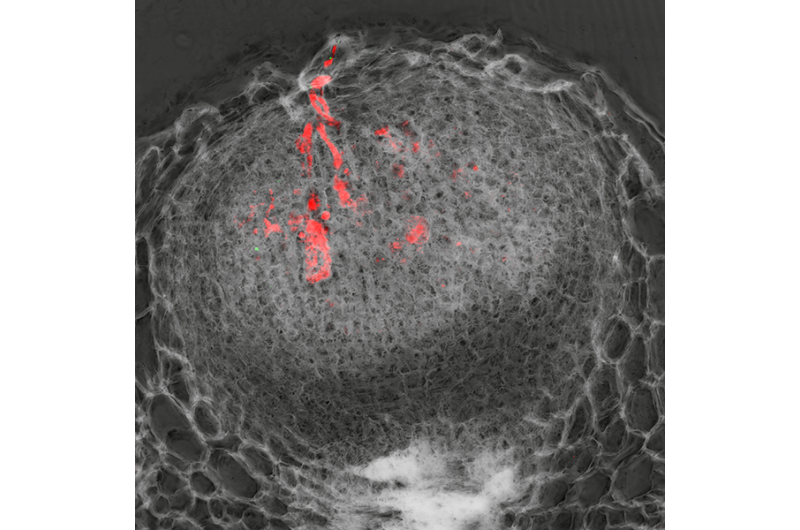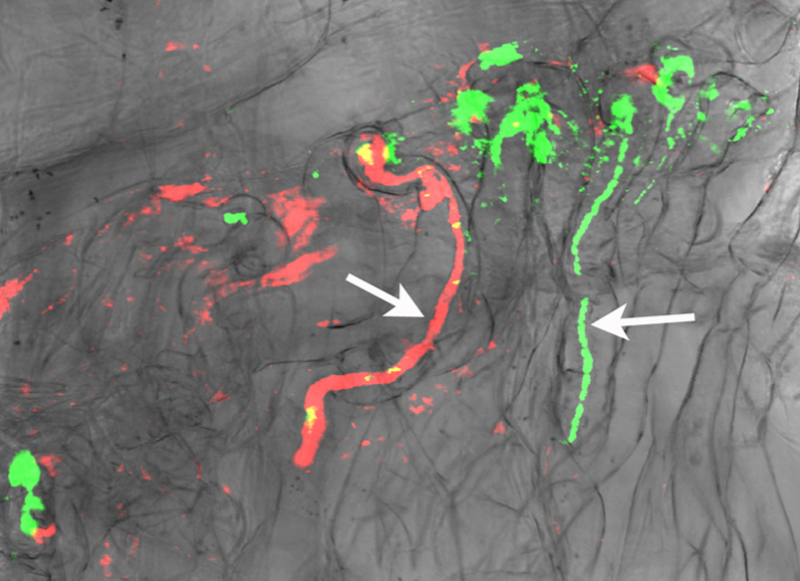Understanding images: A genetic framework in legumes controls infection of nodules

The soil environment harbors a diverse range of bacteria, many of which could potentially be detrimental if they are able to gain entry to plant tissues. We are interested in determining how the host plant selects which bacteria are able to colonize its tissues and to identify important endophyte factors that allow them to be accommodated by the host plant. In this issue of PLOS Genetics we investigate the genetic components and molecular signals that allow the endophyte Rhizobium mesosinicum strain KAW12 (KAW12) to colonize symbiotically induced nodules on the model legume Lotus japonicus. We have used different symbiotic and endophytic strains and performed mixed inoculations of wild-type or symbiotic L. japonicus mutants in order to identify the respective contributions of the different interacting partners – legume host, symbiont and endophyte.
Colonisation of Lotus japonicus Nodules by Endophytic Bacteria
The legume root nodule is a unique environmental niche induced by symbiotic bacteria, where multiple symbiotic and endophytic bacterial species can co-exist. Several endophytes were tested for their ability to colonize L. japonicus nodules that were induced by its usual symbiotic rhizobia (Mesorhizobium loti) in co-inoculation experiments. Our study identified KAW12 as an endophyte that uses the symbiotically induced infection threads to co-colonize L. japonicus nodules without inducing nodule necrosis, providing us with a system to study host and endophyte genetic features that are important for such interactions.
Initiation of the symbiotic process requires Nod-factor signaling. Nod factors are signal molecules produced by symbiotic rhizobia and recognized by the plant through Nod-factor receptors. This perception triggers the initiation of the infection pathway, through which rhizobia enter the plant, as well as initiation of nodule organogenesis. Using symbiotic strains that produce different types of Nod factors as co-inoculating partners, we determined that intact Nod-factor signaling provided by the symbiont is required for nodule colonization by the endophytic KAW12 bacteria.

Exopolysaccharides are Key for Chronic Infection
Exopolysaccharide (EPS) production is important during symbiosis5. The M. loti exoU strain utilized in this study is affected in EPS biosynthesis and is thus impaired in symbiosis due to an inability to form infection threads. To further investigate this we isolated an EPS-deficient strain of KAW12 and performed co-inoculation experiments with M. loti exoU. Strikingly, nodule colonization by the KAW12 EPS mutant was absent, indicating that EPS is a key molecule required by the endophyte to allow for nodule colonization.

Endophyte Nodule Occupancy is Host-Controlled
To study the role of the legume host in mixed inoculations we took advantage of the large collection of L. japonicus mutants available to identify host genetic components required for nodule colonization by the endophyte. Our results revealed that the mutation of genes required for infection thread formation prevented nodule colonization by the KAW12 endophyte. In contrast, KAW12 colonization of nodules formed on plant mutants in genes required for supporting nitrogen-fixation within nodules was not impaired.
The presence of endophytes within legume nodules may restrict the occupancy of effective nitrogen-fixing symbionts and therefore represents a major challenge that contributes to limiting legume cultivation. Our study shows that the well-established genetic resources available for the model legume L. japonicus can be utilised in co-inoculation studies to identify genetic and molecular factors important for determining compatibility with soil bacteria, providing further avenues to address this issue.
More information: 1 Broghammer, A. et al. Legume receptors perceive the rhizobial lipochitin oligosaccharide signal molecules by direct binding. Proc Natl Acad Sci U S A 109, 13859-13864, DOI: 10.1073/pnas.1205171109 (2012).
2 Radutoiu, S. et al. Plant recognition of symbiotic bacteria requires two LysM receptor-like kinases. Nature 425, 585-592 (2003).
3 Oldroyd, G. E. D., Murray, J. D., Poole, P. S. & Downie, J. A. The rules of engagement in the legume-rhizobial symbiosis. Annu. Rev. Genet. 45, 119-144, DOI: 10.1146/annurev-genet-110410-132549 (2011).
4 Kawaharada, Y. et al. Receptor-mediated exopolysaccharide perception controls bacterial infection. Nature 523, 308-12 (2015).
5 Kelly, S. J. et al. Conditional requirement for exopolysaccharide in the Mesorhizobium-Lotus symbiosis. Mol Plant Microbe Interact 26, 319-329, DOI: 10.1094/mpmi-09-12-0227-r (2013).
Journal information: PLoS Genetics , Nature , Proceedings of the National Academy of Sciences
Provided by PLOS Blogs
This story is republished courtesy of PLOS Blogs: blogs.plos.org.



















